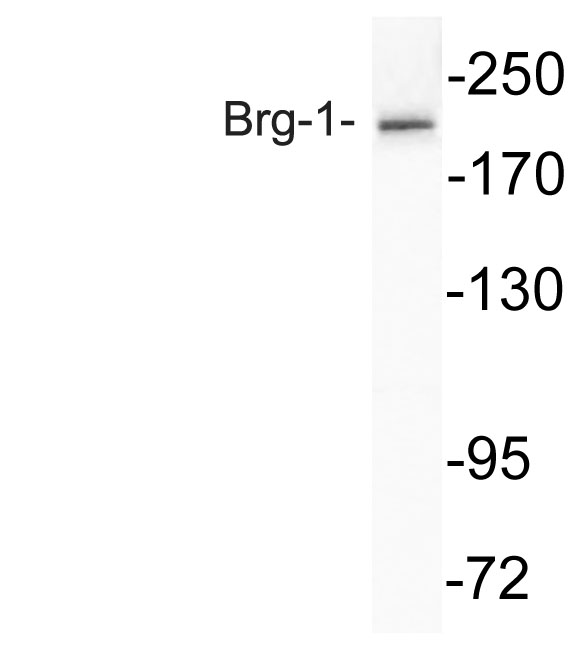Brg-1 Polyclonal Antibody
- Catalog No.:YT0524
- Applications:WB;IF;ELISA
- Reactivity:Human;Mouse;Rat
- Target:
- BRG1
- Fields:
- >>Thermogenesis;>>Hepatocellular carcinoma
- Gene Name:
- SMARCA4
- Protein Name:
- Transcription activator BRG1
- Human Gene Id:
- 6597
- Human Swiss Prot No:
- P51532
- Mouse Gene Id:
- 20586
- Mouse Swiss Prot No:
- Q3TKT4
- Rat Swiss Prot No:
- Q8K1P7
- Immunogen:
- The antiserum was produced against synthesized peptide derived from human Brg-1. AA range:1565-1614
- Specificity:
- Brg-1 Polyclonal Antibody detects endogenous levels of Brg-1 protein.
- Formulation:
- Liquid in PBS containing 50% glycerol, 0.5% BSA and 0.02% sodium azide.
- Source:
- Polyclonal, Rabbit,IgG
- Dilution:
- WB 1:500-2000; IF ICC 1:100-500;ELISA 1:5000-20000
- Purification:
- The antibody was affinity-purified from rabbit antiserum by affinity-chromatography using epitope-specific immunogen.
- Concentration:
- 1 mg/ml
- Storage Stability:
- -15°C to -25°C/1 year(Do not lower than -25°C)
- Other Name:
- SMARCA4;BAF190A;BRG1;SNF2B;SNF2L4;Transcription activator BRG1;ATP-dependent helicase SMARCA4;BRG1-associated factor 190A;BAF190A;Mitotic growth and transcription activator;Protein BRG-1;Protein brahma homolog 1;SNF2-beta;SWI/S
- Observed Band(KD):
- 200kD
- Background:
- The protein encoded by this gene is a member of the SWI/SNF family of proteins and is similar to the brahma protein of Drosophila. Members of this family have helicase and ATPase activities and are thought to regulate transcription of certain genes by altering the chromatin structure around those genes. The encoded protein is part of the large ATP-dependent chromatin remodeling complex SNF/SWI, which is required for transcriptional activation of genes normally repressed by chromatin. In addition, this protein can bind BRCA1, as well as regulate the expression of the tumorigenic protein CD44. Mutations in this gene cause rhabdoid tumor predisposition syndrome type 2. Multiple transcript variants encoding different isoforms have been found for this gene. [provided by RefSeq, May 2012],
- Function:
- function:Transcriptional coactivator cooperating with nuclear hormone receptors to potentiate transcriptional activation. Also involved in vitamin D-coupled transcription regulation via its association with the WINAC complex, a chromatin-remodeling complex recruited by vitamin D receptor (VDR), which is required for the ligand-bound VDR-mediated transrepression of the CYP27B1 gene.,PTM:Phosphorylated upon DNA damage, probably by ATM or ATR.,similarity:Belongs to the SNF2/RAD54 helicase family.,similarity:Contains 1 bromo domain.,similarity:Contains 1 helicase ATP-binding domain.,similarity:Contains 1 helicase C-terminal domain.,similarity:Contains 1 HSA domain.,subunit:Interacts with NR3C1, PGR, SMARD1, TOPBP1 and ZMIM2/ZIMP7. Component of the BAF complex, which includes at least actin (ACTB), ARID1A, ARID1B/BAF250, SMARCA2, SMARCA4/BRG1, ACTL6A/BAF53, ACTL6B/BAF53B, SMARCE1/BAF57, SMARC
- Subcellular Location:
- Nucleus . Colocalizes with long non-coding RNA Evf2 in nuclear RNA clouds. .
- Expression:
- Colocalizes with ZEB1 in E-cadherin-negative cells from established lines, and stroma of normal colon as well as in de-differentiated epithelial cells at the invasion front of colorectal carcinomas (at protein level).
Overexpressed mitogen-and stress-activated protein kinase 1 promotes the resistance of cytarabine in acute myeloid leukemia through brahma related gene 1-mediated upregulation of heme oxygenase-1. EUROPEAN JOURNAL OF PHARMACOLOGY Eur J Pharmacol. 2022 Feb;917:174722 WB,IF Human 1:1000,1:50 THP-1 cell, U937 cell
- June 19-2018
- WESTERN IMMUNOBLOTTING PROTOCOL
- June 19-2018
- IMMUNOHISTOCHEMISTRY-PARAFFIN PROTOCOL
- June 19-2018
- IMMUNOFLUORESCENCE PROTOCOL
- September 08-2020
- FLOW-CYTOMEYRT-PROTOCOL
- May 20-2022
- Cell-Based ELISA│解您多样本WB检测之困扰
- July 13-2018
- CELL-BASED-ELISA-PROTOCOL-FOR-ACETYL-PROTEIN
- July 13-2018
- CELL-BASED-ELISA-PROTOCOL-FOR-PHOSPHO-PROTEIN
- July 13-2018
- Antibody-FAQs
- Products Images

- Western blot analysis of lysate from K562 cells, using Brg-1 antibody.



